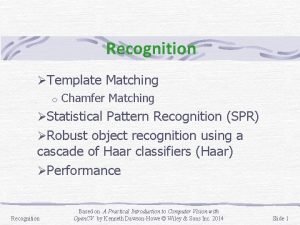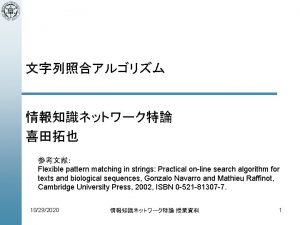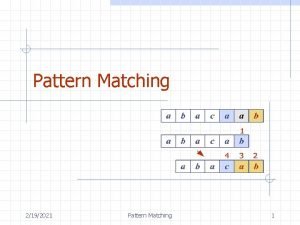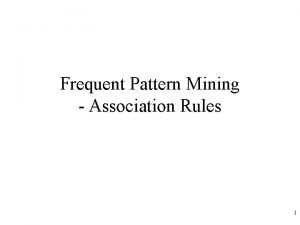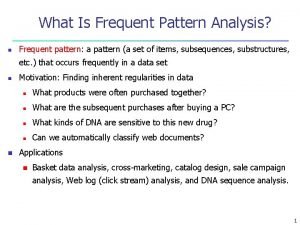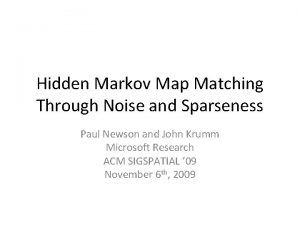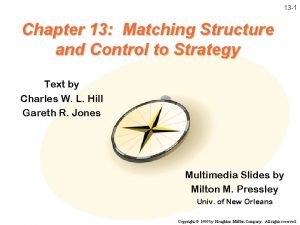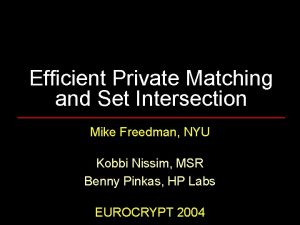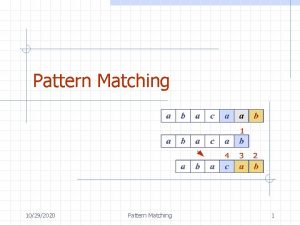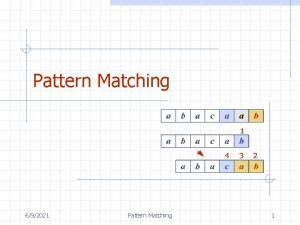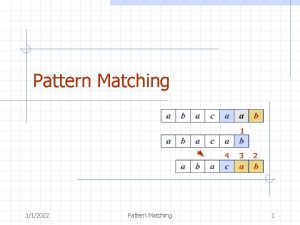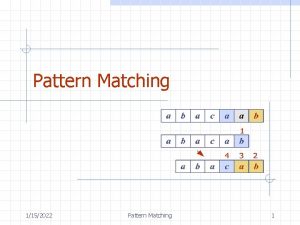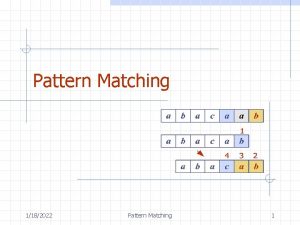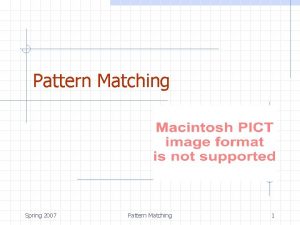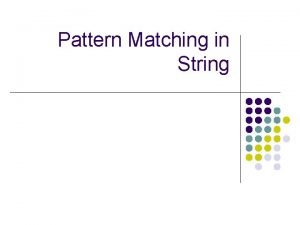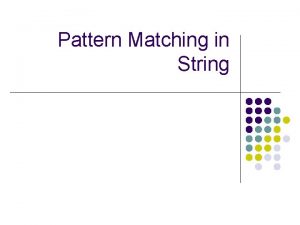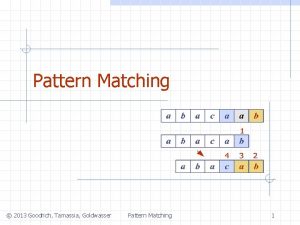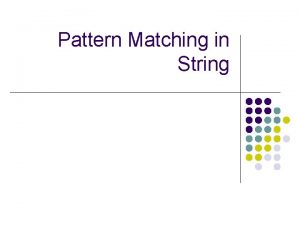Pattern Matching 932021 Pattern Matching 1 Outline and
















![Example j 0 1 2 3 4 5 P[j] a b a c a Example j 0 1 2 3 4 5 P[j] a b a c a](https://slidetodoc.com/presentation_image_h2/839a3b00fa9a4dff5a88aaa846ab69f1/image-17.jpg)
- Slides: 17

Pattern Matching 9/3/2021 Pattern Matching 1

Outline and Reading Strings (§ 11. 1) Pattern matching algorithms (§ 11. 2) n n n 9/3/2021 Brute-force algorithm Boyer-Moore algorithm Knuth-Morris-Pratt algorithm Pattern Matching 2

Strings Let P be a string of size m A string is a sequence of characters Examples of strings: n n n Java program HTML document DNA sequence Digitized image n An alphabet S is the set of possible characters for a family of strings Example of alphabets: n n ASCII Unicode {0, 1} {A, C, G, T} n Given strings T (text) and P (pattern), the pattern matching problem consists of finding a substring of T equal to P Applications: n n n 9/3/2021 A substring P[i. . j] of P is the subsequence of P consisting of the characters with ranks between i and j A prefix of P is a substring of the type P[0. . i] A suffix of P is a substring of the type P[i. . m - 1] Pattern Matching Text editors Search engines Biological research 3

Brute-Force Algorithm The brute-force pattern matching algorithm compares the pattern P with the text T for each possible shift of P relative to T, until either n n a match is found, or all placements of the pattern have been tried Brute-force pattern matching runs in time O(nm) Example of worst case: n n 9/3/2021 T = aaa … ah P = aaah may occur in images and DNA sequences unlikely in English text Algorithm Brute. Force. Match(T, P) Input text T of size n and pattern P of size m Output starting index of a substring of T equal to P or -1 if no such substring exists for i 0 to n - m { test shift i of the pattern } j 0 while j < m T[i + j] = P[j] j j+1 if j = m return i { match at i } else return -1 { no match } Pattern Matching 4

Brute Force 9/3/2021 Pattern Matching 5

Brute Force-Complexity Given a pattern M characters in length, and a text N characters in length. . . Worst case: compares pattern to each substring of text of length M. For example, M=5. This kind of case can occur for image data. Total number of comparisons: M (N-M+1) Worst case time complexity: O(MN) 9/3/2021 Pattern Matching 6

Brute Force-Complexity(cont. ) Given a pattern M characters in length, and a text N characters in length. . . Best case if pattern found: Finds pattern in first M positions of text. For example, M=5. Total number of comparisons: M Best case time complexity: O(M) 9/3/2021 Pattern Matching 7

Brute Force-Complexity(cont. ) Given a pattern M characters in length, and a text N characters in length. . . Best case if pattern not found: Always mismatch on first character. For example, M=5. Total number of comparisons: N Best case time complexity: O(N) 9/3/2021 Pattern Matching 8

Boyer-Moore’s Algorithm (1) The Boyer-Moore’s pattern matching algorithm is based on two heuristics Looking-glass heuristic: Compare P with a subsequence of T moving backwards Character-jump heuristic: When a mismatch occurs at T[i] = c n n If P contains c, shift P to align the last occurrence of c in P with T[i] Else, shift P to align P[0] with T[i + 1] Example 9/3/2021 Pattern Matching 9

Last-Occurrence Function Boyer-Moore’s algorithm preprocesses the pattern P and the alphabet S to build the last-occurrence function L mapping S to integers, where L(c) is defined as n n the largest index i such that P[i] = c or -1 if no such index exists Example: n S = {a, b, c, d} n P = abacab c a b c d L(c) 4 5 3 -1 The last-occurrence function can be represented by an array indexed by the numeric codes of the characters The last-occurrence function can be computed in time O(m + s), where m is the size of P and s is the size of S 9/3/2021 Pattern Matching 10

Boyer-Moore’s Algorithm (2) Algorithm Boyer. Moore. Match(T, P, S) L last. Occurence. Function(P, S ) i m-1 j m-1 repeat if T[i] = P[j] if j = 0 return i { match at i } else i i-1 j j-1 else { character-jump } l L[T[i]] i i + m – min(j, 1 + l) j m-1 until i > n - 1 return -1 { no match } 9/3/2021 Case 1: j 1 + l Case 2: 1 + l j Pattern Matching 11

Example 9/3/2021 Pattern Matching 12

Analysis Boyer-Moore’s algorithm runs in time O(nm + s) Example of worst case: n n T = aaa … a P = baaa The worst case may occur in images and DNA sequences but is unlikely in English text Boyer-Moore’s algorithm is significantly faster than the brute-force algorithm on English text 9/3/2021 Pattern Matching 13

KMP’s Algorithm (1) Knuth-Morris-Pratt’s algorithm preprocesses the pattern to find matches of prefixes of the pattern with the pattern itself The failure function F(i) is defined as the size of the largest prefix of P[0. . j] that is also a suffix of P[1. . j] Knuth-Morris-Pratt’s algorithm modifies the brute-force algorithm so that if a mismatch occurs at P[j] T[i] we set j F(j - 1) 9/3/2021 j 0 1 2 3 4 5 P[j] a b a F(j) 0 0 1 1 2 3 Pattern Matching 14

KMP’s Algorithm (2) The failure function can be represented by an array and can be computed in O(m) time 9/3/2021 Algorithm Failure. Function( P) i 1 j 0 F[0] 0 while i < m if P[i] = P[j] F[i ] j + 1 i i+1 j j+1 else if j > 0 j F[j - 1] else F[i ] 0 i i+1 return F Pattern Matching 15

KMP’s Algorithm (3) At each iteration of the while-loop, either n n i increases by one, or the shift amount i - j increases by at least one (observe that F(j - 1) < j) Hence, there are no more than 2 n iterations of the while-loop Thus, KMP’s algorithm runs in optimal time O(m + n) 9/3/2021 Algorithm KMPMatch(T, P) F failure. Function(P) i 0 j 0 while i < n if T[i] = P[j] if j = m - 1 return i - j { match } else i i+1 j j+1 else if j > 0 j F[j - 1] else i i+1 return -1 { no match } Pattern Matching 16
![Example j 0 1 2 3 4 5 Pj a b a c a Example j 0 1 2 3 4 5 P[j] a b a c a](https://slidetodoc.com/presentation_image_h2/839a3b00fa9a4dff5a88aaa846ab69f1/image-17.jpg)
Example j 0 1 2 3 4 5 P[j] a b a c a b F(j) 0 0 1 2 9/3/2021 Pattern Matching 17
 Example of topic outline and sentence outline
Example of topic outline and sentence outline Template matching pattern recognition
Template matching pattern recognition Flexible pattern
Flexible pattern Knuth morris pratt pattern matching algorithm
Knuth morris pratt pattern matching algorithm Graph pattern matching algorithm
Graph pattern matching algorithm Brute force pseudocode
Brute force pseudocode What is brute force algorithm
What is brute force algorithm Subsequence pattern matching
Subsequence pattern matching Sub secondary classification formula
Sub secondary classification formula Pattern and pattern classes in image processing
Pattern and pattern classes in image processing Max pattern and closed pattern
Max pattern and closed pattern Frequent pattern
Frequent pattern Hidden markov map matching through noise and sparseness
Hidden markov map matching through noise and sparseness Matching structure with strategy
Matching structure with strategy Efficient private matching and set intersection
Efficient private matching and set intersection Supply demand matching
Supply demand matching Matching muscle directions and positions
Matching muscle directions and positions Jingles are musical messages written around the brand.
Jingles are musical messages written around the brand.

